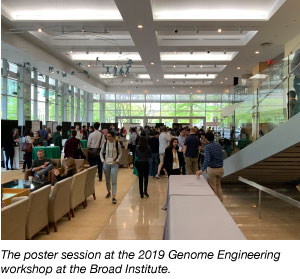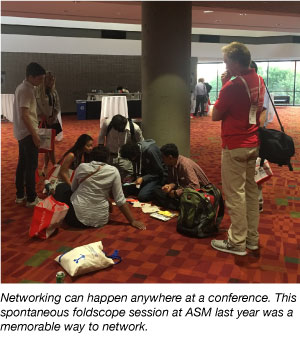So you’ve done the research, gathered up your data into an exciting story, and are ready to present your findings at a conference. But what you get out of a conference depends on what you put into it before, during, and after the meeting. Let’s break it down into the following: the elevator pitch, talks, the poster session, networking, and social media.
The elevator pitch
Before the conference
Practice your “elevator pitch,” the 30 - 60 second blurb you will use to introduce yourself and what you do. You might want to include your university and your advisor’s name for some context and maybe common ground. The people you meet may all be scientists but not all will be familiar with the specifics of your research. Try to avoid jargon in this initial introduction.
During the conference
When you meet someone new at a conference, one of the first things you might want to know is what their project is. Or maybe you want to introduce yourself to a scientist whose work you are familiar with. You can tweak your elevator pitch slightly if you know a bit more about the other person. If you have a poster or talk at the conference, you can end by asking them to come to your poster or talk.
After the conference
After using your elevator pitch several times at the conference, you might notice some trends. Were there parts of your elevator pitch where the other person seemed confused, bored, or particularly excited about? If you tried tweaking your pitch throughout the conference, what worked? Use this information to prepare for the next meeting.
Navigating talks
Before the conference
Is the conference you are attending on the larger side? At large conferences, chances are that several talks will be going on at once in different rooms. Before arriving at the conference, plan out your agenda. Some conferences even have apps you can use to build a schedule. If there is a list of poster titles or abstracts available before the conference, comb through that list and note which posters you’d like to go to.
During the conference
Take notes during talks. If you have questions during the talk, jot them down for the Q&A immediately after. For one conference I went to, I made it a personal goal to ask one question each day (this may be more or less difficult depending on the size of the conference). This made sure I didn’t zone out and kept me engaged throughout the day.
After the conference
If there’s a cool new method that you learned about at the talk, bring it to your next lab meeting. Don’t be afraid to follow up with the speaker from the conference if you have additional questions. If you or your lab identifies a potential collaborator from the meeting, reach out to them, pointing out that you heard their talk at the meeting and why you think a collaboration would be beneficial.
The poster session
Before the conference
If you’re presenting a poster at a conference, be sure to practice beforehand. Generally, two types of people will visit your poster: those that want you to walk them through the entire poster, or those that want to look through themselves and then ask questions. Practice your presentation for both instances. If your poster material is nearing publication, consider uploading your work to a preprint server (and include this information on the poster) so your visitors can have a DOI to go to.
 During the conference
During the conference
Arrive at the poster session early to get your poster up on the board and meet your poster session neighbors. During the session, if someone comes up to my poster, I usually greet them and say something like “Let me know if you have questions or if you want me to walk you through the poster.” Have a notebook handy so you can jot down notes or questions from your poster viewers and trade contact information if your conversation is particularly fruitful.
After the conference
Bring back what you’ve learned from the poster session to your lab. Perhaps some of your poster visitors had a great idea or interesting questions worth discussing with your lab. If you made a connection during the poster session, send them a follow up email thanking them for their conversation and connect with them on social media.
Social media
Before the conference
Networking can be made easier through social media. Use social media to find out who’s going to the conference and who you’d like to talk to there. Check out the conference website for any relevant hashtags and handles to help you find other scientists attending. Reach out if you’d like to meet someone and set aside a time to meet. Some conferences may also have a dedicated app with a social media component, but if it doesn’t seem like this is being used, it’s best to turn to an established social media platform.
During the conference
If the conference has a social media policy, this should be on their website or the program booklet. Make sure you’re familiar with the policies before posting something on social media. If someone is presenting unpublished data they may ask the audience to not share their research on social media. Use the hashtag if you are live-tweeting any sessions that the presenter doesn’t mind sharing on social media. If you could not attend some of the sessions, you can see if others have live-tweeted as well. In addition to using social media for sharing new scientific information from the conference, many conferences also have “tweep ups” where you can meet those you’ve interacted with on science Twitter in real life. If there is not a tweep up, create one yourself. Pick a time (ex: lunch, happy hour) and use the conference hashtag to set one up. It’s also helpful to write your Twitter handle on your nametag for the tweep up (and for the entire conference, in general).
After the conference
Review your favorite conference moments on social media and if there was something you missed during the conference, you can try getting up to speed on social media. If you haven’t already, connect with those you’ve met at the conference.
Networking
All of the things we've mentioned above could be considered networking, but here are some more general tips.
Before the conference
Networking is key even if you are not looking for a job - those connections can help you later on. Update your LinkedIn and your resume and prepare business cards. You might not consider being a student or postdoc a “business,” but having business cards is a good way to share your information quickly.
 During the conference
During the conference
Arriving at the conference can be overwhelming when you are presented with a sea of strangers. Try things like sitting at a table for lunch with people you don’t know or attending social events. I like to set goals for myself like meet ten new people each day. Exchange business cards. When you’re done networking for the day (or whenever you have a small break), write down some notes on the card so you remember who they are and what you’ve talked about.
After the conference
Follow up with those that you’ve met. Connect with people on LinkedIn or Twitter, for instance. If you’ve had a particularly meaningful conversation, and you have their email address, you can send them a note.
After reading this, you probably notice a trend: networking happens everywhere! Even when you aren’t “trying to network.” For some more networking tips not covered here, head over to the “How to Make Friends and Meet People at a Scientific Conference” blog post.
There’s so many great tips for getting the most from your conference experience so we unfortunately couldn’t cover them all. What are your top tips for getting the most out of your scientific conference?
Resources on the Addgene blog
- Read other posts on scientific sharing, scientific communication, and scientific networking
- Learn how to set up and informational interview and Expand your professional network
- Volunteer at a professional organization to expand your skill set
Resources on the Addgene website
- Become of a member of the Addgene depositor community
Topics: Science Careers, Networking, Conferences






Leave a Comment